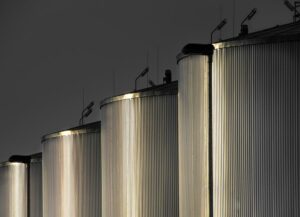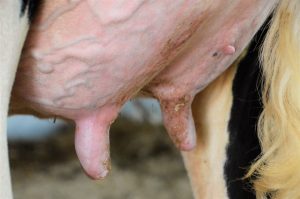Maria Villagrasa & Fernando Diaz
One strategy to reduce the likelihood of ruminal acidosis is to replace starch with sugars. Some experiments have suggested that molasses can increase feed intake and milk production, and that replacing starch with sugars in the cow’s diet does not increase the risk of ruminal acidosis.
Molasses has approximately 75% dry matter (DM) of which 80% are sugars. This makes it very palatable and a good source of energy for cattle for cattle. They degrade easily in the rumen, resulting in a typical butyric acid fermentation.
The protein fraction, at approximately 4%, is fully soluble, with 50% non-protein nitrogen, 50% amino acids (mainly aspartic and glutamic), and a low concentration of essential amino acids. It is also a rich source of calcium, chlorine and magnesium.
A research experiment (Razzaghi et al., 2020) evaluated the effects of feeding sugarcane molasses with or without the addition of a ruminal buffer, over ruminal fermentation parameters, fatty acid (FA) profile and milk production and composition in diets of dairy cows fed high concentrate.
The buffer compound supplemented consisted of both buffering and alkalizing agents (i.e. mixture of baking soda, sodium bentonite, calcium carbonate, potassium carbonate and magnesium oxide, which supplied 8.7% Na, 9.3% Mg, 1. 2% K and 10. 6% Ca) and was offered at 180 g/cow daily.
Eight Holstein multiparous cows were divided in two groups: 4 with a rumen cannula and four without it, receiving the following diets:
- No supplementation (control)
- Molasses (5%) with no buffer supplementation (Molasses)
- Buffer (0.8%) with no molasses supplementation (Buffer)
- Molasses (5%) plus buffer supplementation (0.8%; Combined)
These four isonitrogenous and isoenergetic diets were formulated by replacing (DM basis) 5% of ground corn with molasses, while the buffer replaced wheat bran at 0.8% of the diet. A total mixed ration of high concentrate (forage:concentrate ration 35:65; DM basis) was formulated to be potentially acidifying.
All experimental diets contained similar concentrations (DM basis) of protein 17.1%, neutral detergent fiber 29.6%, acid detergent fiber 16%, non-fibrous carbohydrates 45.6%, net energy of lactation 1.66 Mcal/kg, and starch 31.4 – 34.2%. The concentration in the diets with and without molasses was 8.7 and 4.4% DM.
The ruminal proportion of butyrate increased in cows fed molasses diets (molasses and combined) compared to the others. In contrast, the ruminal molar ratio of acetate was higher in cows in the buffered diets (buffer and combined) compared to the molasses diet.
In addition, the ruminal molar ratio of propionate was slightly reduced in cows fed the diet with molasses compared to the control, but its reduction was more effective in cows fed the buffered diet. As a result, the acetate:propionate ratio in the rumen increased when cows were fed the molasses or buffer diet compared to the control.
The molasses diet and buffering diet were effective in reducing the time that rumen pH was below 5.8 compared to the control diet. In contrast, the mean rumen pH was not affected by treatments.
Fatty acid profile
The total proportions of short and medium chain fatty acids (FA) in milk were higher in the cows fed diets containing molasses, while the inclusion of molasses decreased total trans-18:1 FA in milk fat. In addition, the proportions of total long-chain FA and total unsaturated FA were reduced with the molasses and combined diet.
Feeding with molasses or buffers significantly reduced the proportion of trans-10 18:1 in milk fat compared to the control diet, but the reduction was even more pronounced in cows in the combined diet.
Milk fat concentration increased in molasses-fed cows
Milk production (31.0 kg/d), milk protein concentrations and yield (3.16% and 0.98 kg/d, respectively), and solids non-fat (8.14% and 2.54 kg/d, respectively) were not affected by the inclusion of molasses.
Dry matter intake (control 22.2 kg/d; molasses 22.9 kg/d; buffer 23.3 kg/d and combined 23.7 kg/d), energy-corrected milk production (ECM; control 29.2 kg/d; molasses 31.9 kg/d; buffered 32.1 kg/d and combined 32.7 kg/d) was increased in molasses-fed cows with respect to buffered diets.
Diets supplemented with molasses and buffering showed a higher fat content, so that compared to the control diet (2.90%), the fat concentration in milk increased in molasses-fed cows (3.74%) buffering (3.79%) and the combined diet increased it further (3.84%). The response followed the same pattern for fat production (kg/d): control 0.92; 1.15; buffering 1.18 and combined 1.21.
Conclusions
- Molasses and buffering diets reduced the time rumen pH remained below 5.8, so they have the potential to reduce the onset of subacute ruminal acidosis in cows fed acidosis generating diets.
- The proportions of trans-10 18: 1 FA and total trans FA decreased significantly with molasses or buffering supplementation.
- Molasses diets increased short- and medium-chain FA concentrations in milk fat. The production of fat-corrected milk at 3.5% increased significantly in molasses or buffer-fed cows due to the higher concentration of milk fat.
The results of this study indicate that, in general, the inclusion of molasses and buffer reduces trans-10 18:1 FA and total trans FA in milk by modulating ruminal pH and volatile FA profile in the diet of dairy cows fed high concentrates.
Reference
A. Razzaghi, R. Valizadeh, M.H. Ghaffari, and A. F. Brito. 2020. Liquid molasses interacts with buffers to affect ruminal fermentation, milk fatty acid profile, and milk fat synthesis in dairy cows fed high-concentrate diets. J. Dairy Sci. 103:4327–4339.
© 2020 Dairy Knowledge Center. All Rights Reserved.











